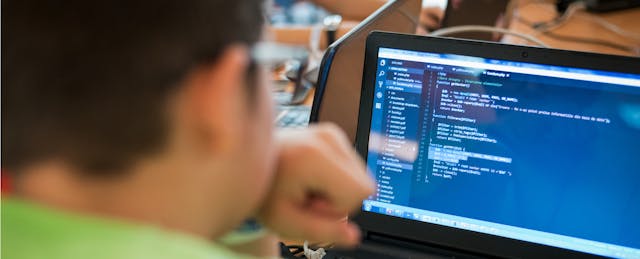In a year of continued challenges for educators, advocates for computer science education are serving up some good news. This year marked a tipping point for these tech-focused programs, with 51 percent of high schools nationwide now offering at least one computer science class.
That’s according to the 2021 State of Computer Science report jointly released last week by the Code.org Advocacy Coalition, Computer Science Teachers Association and the Expanding Computing Education Pathways Alliance. The figure is based on data from public high schools in 37 states, a first for the report.
“It has been an absolutely tremendous year for computer science education growth for K-12,” says Katie Hendrickson, president of the Code.org Advocacy Coalition and director of State Government Affairs for the group. “We’re thrilled that finally over half of schools offer it. That still means that another half of schools don’t offer it. Students who attend those schools don’t even have the opportunity to take a course if they wanted to.”
The group has issued nine state-level policy recommendations aimed at increasing computer science offerings in schools. The recommendations range from clearly defining computer science to funding teacher training and allowing computer science to count toward students’ graduation requirements.
Data shows those policies are working, Hendrickson says, and states that adopt more of them see computer science programs growing. She pointed to South Carolina, which makes computer science part of high school graduation requirements, as an example. The state has 21 percent of its students enrolled in the tech courses compared to the 5 percent national average, Hendrickson says.
“We want to celebrate all the momentum we’ve seen for computer science education over the past year,” Hendrickson says, “but we really need to accelerate policy adoption and implementation efforts to ensure that we’re still scaling equitably and making sure that under-resourced schools have the same rate of access as those more privileged schools.”
The Pandemic’s Impact
Hendrickson says the pandemic did have consequences for computer science in schools, such as the diverting of funds for those programs. But the reach and enrollment in CS nationwide continues to grow.
Over the past year, Illinois, Mississippi and Oklahoma joined the 20 other states that require all high schools to offer computer science classes. Thirty-one states have adopted policies in support of computer science education and funding during that time.
When the pandemic forced schools to go online, it also increased the number of students who had access to computers and the internet at home. Data shows the percentage of middle and high schools with 1:1 device policies reached 90 percent, an increase of 24 points. That led some to offer computer science courses to younger students and expand their offerings in upper grade levels to include data science or cybersecurity, according to the report.
“Schools that were struggling with all these other challenges, but many were still prioritizing and seeing computer science as core and important for students to have those opportunities,” Hendrickson says. “I’m anticipating that over the next few years, we’re going to see folks leveraging those tools to start teaching computer science for the first time.”
The Equity Element
As computer science offerings grow, so too does the need to make sure they are accessible to students from all backgrounds.
“The one major piece to consider is that equity should be part of the development and implementation of these policies that we recommend,” Hendrickson says. “[Leaders] should make sure that they’re scaling to the most underresouced schools.”
Those efforts include things like making sure counselors know how to guide students to enroll in computer science and ensuring all students feel supported.
When it comes to representation, the report shows economically disadvantaged students are underrepresented in CS courses. And so are Latino students. Across 36 states, girls made up 31 percent of computer science students, according to the data.
While Native American and Black students were the least likely to attend a school that offered computer science, their enrollment in computer science classes was on par with their overall populations.
Hendrickson says that just as K-12 students get a foundation in subjects like biology and mathematics, they need the same introduction to tech for the world they’re growing up in.
If students take just one computer science course, Hendrickson says, “it breaks the stereotype they might have of computer programers sitting in their basement and staring at their screens all day.” Rather, she adds, students experience the creativity and teamwork that goes into programming, and foundational courses increase the likelihood that students will choose it as their major in college.
“Just having that one opportunity opens their eyes and see how they can change the world with computer science,” she says, adding that “it helps them see a place for them inside it, as well.”


